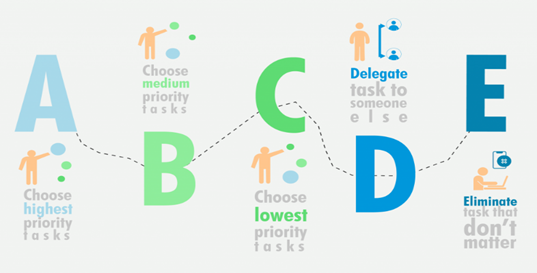Use the ABCDE Method.
Daily Use the ABCDE Method for setting priorities on your work. Place one of these letters before each task on your list before you begin.
“A” – Most Important task
An “A” task is something that is important. It is something you must do. It is something for which there are significant consequences if you do it or fail to do it. If you have more than one “A” task to do, organize them as A-1, A-2, A-3, and so on, in order of importance.
“B” – Minor Important task
A “B” task is something that you should do. It has mild consequences if it is done or not done. But it is not as important as an “A” task. The rule is that you never work on a “B” task when there is an “A” task left undone. You refuse to work on a lower priority when there is a higher priority waiting.
“C” – Nice to do
A “C” task is something that would be nice to do, but which has no consequences at all. For example, reading the paper, going for coffee with a coworker or phoning home to see what’s for dinner are all “C” tasks. They contribute nothing to your job or your success. Never work on a “C” task when there is a “B” task left undone.
“D” – Delegate
A “D” task is anything you can delegate to someone else. The rule is that you should delegate everything that can possibly be done by anyone else so that you can free up more time to do the few things that only you can do. Ask yourself, “What can I and only I do, that if done well, will make a real difference to my company?” Delegate as much as possible so that you can spend more time working on the one task that is the answer to this question, the one task that can really make a difference.
“E” – Eliminate
An “E” task is something that you can eliminate. Doing it or not doing it has no consequences at all. It is something that may have been important in the past but which you can discontinue today, and it will make no real difference to your job or to your future.
ABCDE Method Examples
A project manager deals with competing priorities every day. Although they can use a project management tool to identify priorities, essentially, it’s the discretion of the manager to determine what a priority is and what is not.
Say you are a project manager with 1,001 things to do, including effective resource management and project cost management. You start to feel overwhelmed by the number of things you need to get done. Every task feels important. Your success depends on deciding what tasks you choose to do and what you leave out.
So, how does the ABCDE Method work in this case? You could, for example, implement it as follows.
First, write down everything that needs to be done tomorrow.
The next step is to prioritize. Place an A, B, C, D, or E next to each task. Your list could look like this:
A-1 finish a report your superior needs for an upcoming meeting
A-2 meet a key supplier
At this point, remember not to start on a B task until all the As are completed.
B-1 check and reply to your emails
B-2 return a call to the HR department
B-3 do an employee one-year performance appraisal
Similarly, to the above, don’t start on C-tasks until all the As and Bs are cleared.
C-1 update your social media accounts
C-2 call a friend during work hours
C-3 get a daily update on the news

